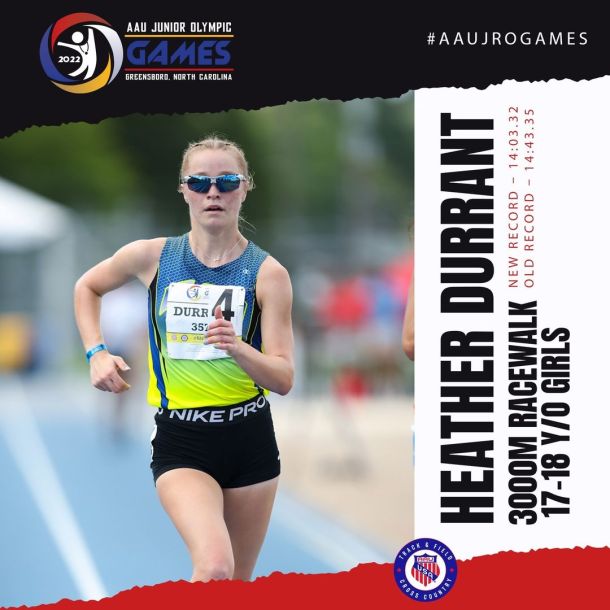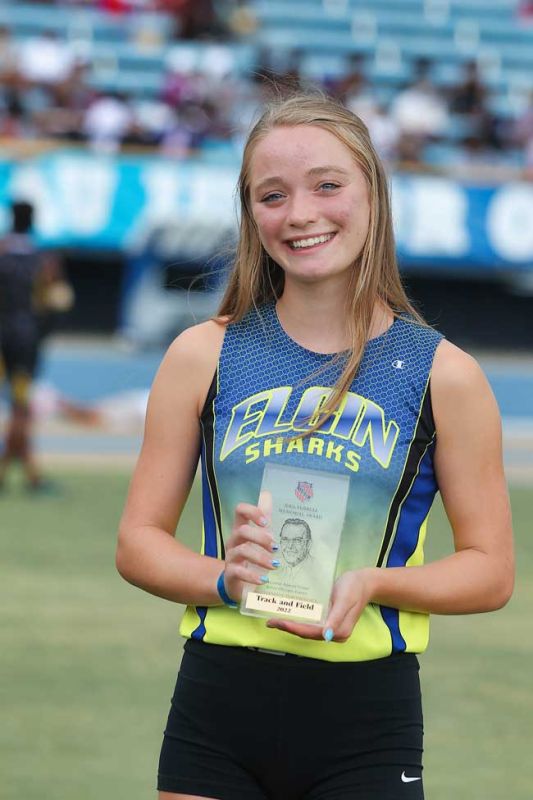Track & Field
Sports
Back
Events/Results
Back
Cross Country Season
Indoor Track & Field Events
More
Back
Mar 02, 2023
Original article by Lauren Keating published in Youth Runner Magazine
There was once a time when racewalking wasn’t as respected as other track and field events. Racewalking was viewed as being “easy” or that these athletes didn’t have what it took to be runners. And while there still remains a trace of that stigma today—especially among boys who might be embarrassed to pursue it—there are twin sisters that are taking race walking by storm and inspiring all young athletes. Heather and Hannah Durrant are the duos that are turning heads and shining the spotlight on race walking.
“There’s a lot more to think about when you’re racewalking than running,” Heather Durrant said, adding that she doesn’t think about form when running.
Her twin Hannah is the opposite.
She agreed that while racewalking isn’t easier than running events, it comes more naturally to her than running. “When I run, my form sometimes turns into a race walk when I’m tired,” she said. “When I run, I have to think about my form more. I have to lift my knee higher because of how much I racewalk,” she said.
Racewalking made its Olympic Games debut in 1904. It’s an event that is strict on the rules and requires precise form.
Racewalkers have to keep muscles and shoulders relaxed while constantly remembering to move heel, toe, heel, toe, pushing off with the toe. Hannah added that it’s important to stay low to the ground and make sure the athlete isn’t lifting—have both feet off the ground. “And make sure when you strike you aren’t landing flat-footed,” she said.
Form also requires a straight leg. A bent knee may cause a penalty. In running events, athletes are encouraged to give it all they have to the end no matter what form looks like. For racewalkers, this could result in disqualification.
“Once you hit that one speed, it looks like you’re almost running,” Hannah said. It takes discipline and focus not to sprint to the finish, finding that balance of giving it one’s all while still respecting the rules.
“The first thing you have to learn about racewalking is technique,” the twins’ race walking mentor Butch Peters said. “A lot of mistakes kids make is they come into race walking and they think they have to go fast first away and that’s not how you learn how to race walk. You have to learn the technique first and then speed eventually comes as you get better at it.”
Hannah describes her race walking form as smooth. “I don’t worry about my pace. I first get the form down, then I speed up as the form feels right. When I’m more relaxed my muscles don’t tense."
First comes solid form for Heather. Then comes the cadence which creates a rhythm that she rides to. “It all comes together,” she said.
“Despite their genetic similarities, they have developed their own unique race walking and running styles, and despite being unique in many of their endeavors, they complement and complete each other too,” Dr. David Durrant, the twins’ father, said.
In the Durrants’ home state of Illinois race walking and running coach Scott Kurth said the focus in track and field is on speed. Race walking continues to not be a popular track and field event across the United States. But Kurth said the girls were willing to try the “go long, go slow” philosophy to become great race walkers.
Kurth, who serves as a “spiritual and technique guide” and who currently works with the girls off season, revealed the girls worked hard on stride length and cadence and mimic each other when training so that their technique is becoming “flawless."
“The first year is always the hardest,” Heather said. She added that it’s challenging to get the form down, calling it all “mental.” But she said to give it time, and it will become easier and eventually everything clicks.
RISING STAR POWER
With the help of athletes like the Durrant sisters, racewalking is increasingly gaining respect.
Heather Durrant has reached All American Status in race walking more than ten times. Increasing in confidence in her abilities and promise in the sport, this talented teen has been on fire–especially this past year.
In April 2022, Heather competed in the 10k racewalk at the USATF U20 Outdoor Track and Field Championships held at Hayward Field in Eugene, Oregon. She finished in third place making history as one of the three U20 female athletes to finish the 10k racewalk event in under 50 minutes. She finished in 49:55.88. This qualified her as an alternate on Team USA.
However, she was disappointed when she did not make one of the top two positions to compete.
With more fuel to take on her next goals, Heather participated in the 2022 USATF National Junior Olympic Track and Field Championships at Hornets Stadium in Sacramento, California just a month later. She finished in first place with a time of 13:49.08 in the 3K race walking event, shattering the previous record.
Then a few days later, Heather competed at the 2022 AAU Junior Olympic Games held at the North Carolina AT&T Stadium in Greensboro. Heather had a record-breaking performance in the 17-18-year-old women’s 3000m racewalk event, setting a new AAU national meet record of 14:03.32.

“To see how Heather blew the national record away was incredible,” AAU Track & Field National Executive Committee Vice-Chair/Administration Marchan Adkins said. “She didn’t just break the race walking record,” he added. “She destroyed it.”
Her twin Hannah was also victorious, coming in second place with a time of 15:55.84.
“I’ve been following all of the Durrants since they were kids,” Adkins said. “And to see Heather and Hannah come into their own and watch them finish one and two was amazing.”
Heather also competed in the 1500m run at the AAU Junior Olympic Games, where she won with a finish time of 4:50.4. It is rare for an athlete to excel at both racewalking and running events.
Adkins recalled watching the event from the press box with commentary from the announcer saying that they have never seen anyone break a race walk national record and then go on to win a running event.
“A lot of people underestimate racewalkers,” Adkins said. “It takes a whole lot of strength, skill, and disciple to be a racewalker and that enhances Heather and Hannah’s ability to run because they are incredible runners as well–and have been for a decade or so now.”
Because of her performance at the AAU Junior Olympic Games, Heather was awarded with the prestigious Joel Ferrell Memorial Award, presented to her at the AAU 2022 Junior Olympic Games. The award was established to recognize performance and sportsmanship and is given to one male or female athlete in each sport at the Games. Heather’s name is engraved on a special plaque at the AAU National Headquarters.

“I think the AAU Junior Olympic Games serve as the starting point for great athletes to excel to higher levels,” Adkins said. “The top athletes that you see in the Olympics were once them,” he said, adding that the future of the Durrant twins looks bright.
“I see Heather as an Olympic athlete,” Kurth, a coach since 1980, said “She’s a finely tuned athlete and her greatness is going to show as we plan in the next four to eight years to be in the Olympics. There are not many athletes that can say that.” And he would know as he’s coached Olympians and pro triathletes before.
When coach Kurth took the girls on as a coach for training during their high school off-season, he told them that their future is in racewalking. He added that they have a skill set that in the U.S. you just don’t see.
He also sees a long future in race walking for Hannah. The twin is also no stranger to notoriety in the racewalking world either. She is a six-time All-American race walker who competed in more than 10 Junior Olympic Games. She holds a 56:34.69 PR in the 10000 m race walk, set at the USATF U20 Outdoor Championships in Eugene, Oregon in June 2022.
It can be hard to be a twin when your sister is one of the top competitors in the country. “To be in that position and the improvements she has made in a short year is amazing,” Kurth said. “The strides Hannah has made are immense.”
This includes cutting minutes off her finish times and strategies like learning how to increase and change tempo and how to read someone else’s tempo.
“There is no sibling rivalry. They complement, push each other and love each other’s success. I think that’s what’s incredible,” Adkins said. “They continue to push each other. There wouldn’t be this level of talent in Heather if it wasn’t for Hannah.”
These 17-year-old twins are the poster children for rising above all odds, facing hardships and obstacles yet finding their footing in the youth-running world. Heather and Hannah have overcome health issues, and injuries and have had their disappointments in competitive racing. As their star power continues to rise, so does the talk about the bright futures of the race walking and running twins.